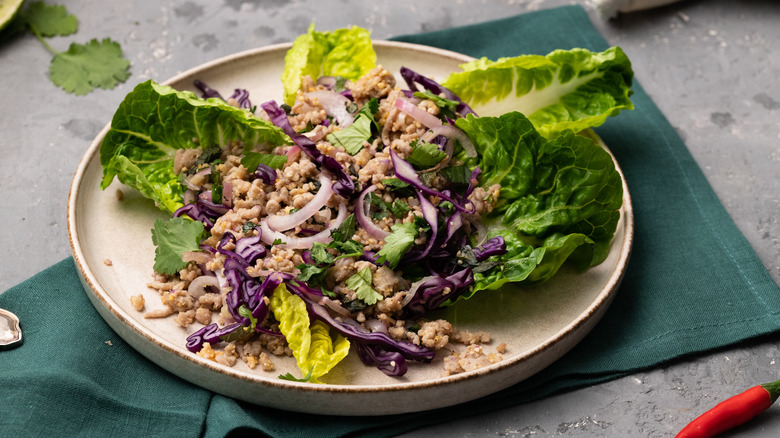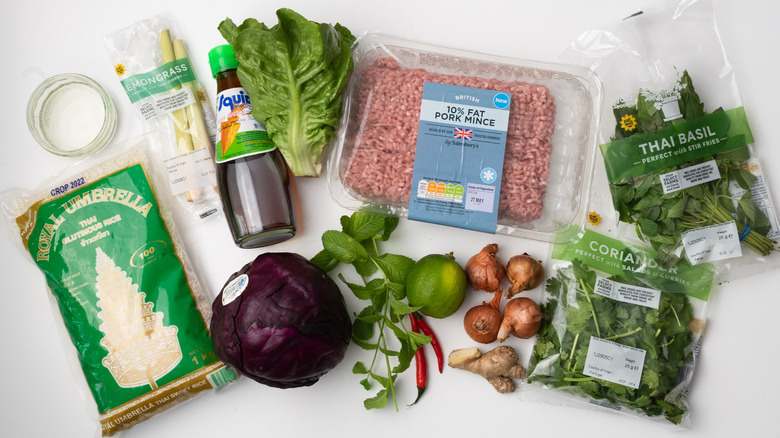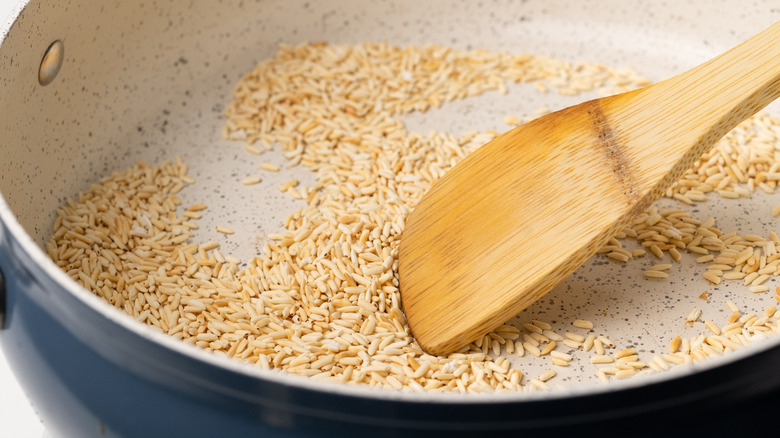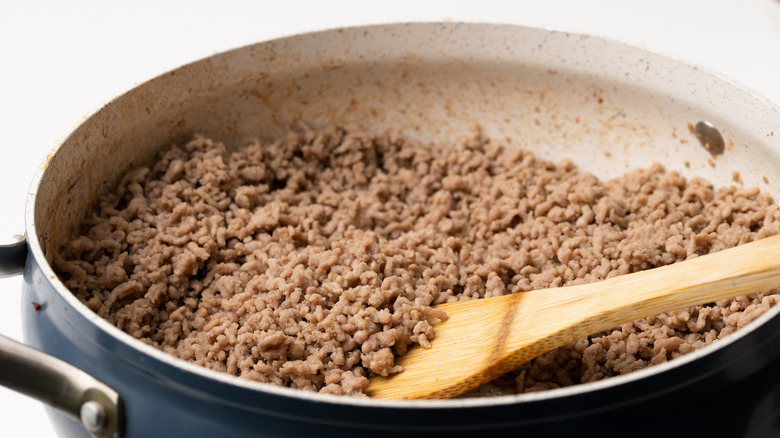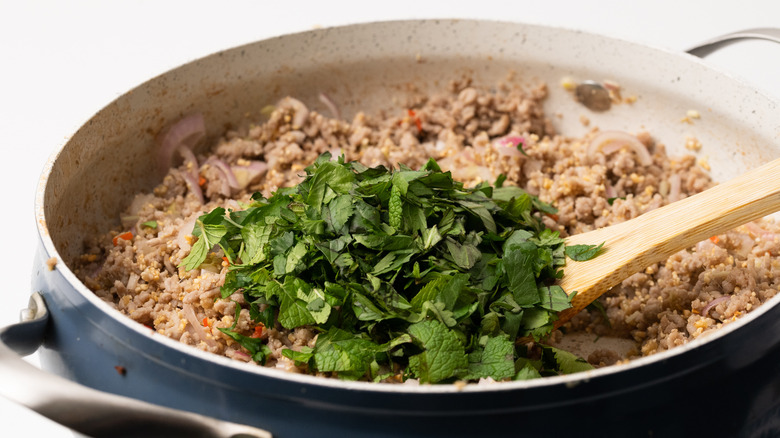Thai Pork Larb Recipe
Have you come across larb before? A classic meat salad from Thailand, this popular and fragrant dish is also translated as lap, lahb, laab, or laap. Although also commonly made with duck, chicken, turkey, or even mushrooms for non-meat eaters, this version of this well-loved Thai dish created by Tasting Table recipe developer Jennine Rye is made using pork mince. The mince is fried with other aromatic and pungent additions such as fish sauce and shallots and then served mixed with an array of fresh herbs and other staple Thai flavors like lemongrass, lime, and ginger. Finally, it is combined with ground toasted rice, red cabbage, and fresh lettuce leaves to give it a delightful texture and crunch.
If you enjoy Thai cuisine you will be sure to love this fresh, colorful, and flavorful dish, which is perfect for either lunch or dinner and can be served as either a starter or a main meal. Quick to throw together and delicious to eat, read on to find out how you can make this Thai pork larb recipe at home.
Gather the ingredients for this Thai pork larb recipe
To make this Thai pork larb recipe, first you will want to gather the ingredients. This dish uses a lot of fresh ingredients, most of which should be easily sourced from your local supermarket. You will need Thai glutinous rice, pork mince, cooking oil, fish sauce, shallots, ginger, lemongrass, bird's eye chilies, a lime, mint, cilantro, Thai basil, red cabbage, and gem lettuce.
If you are unable to find pork mince or wish to substitute it for another meat, this recipe works equally well with chicken mince, turkey mince, beef mince, or duck mince. Similarly, if you are unable to find Thai basil, this ingredient can be substituted for regular basil.
Toast the rice
Glutinous rice powder is a small but very important addition to larb, in fact, so important that some people consider the dish to not be Thai larb unless this specific ingredient is included. Although it can be bought from certain supermarkets, preparing the sticky, glutinous rice powder is very simple to do, and the homemade version is far superior to the prepackaged varieties.
To make the powder, the first step is to toast the glutinous rice, also known as Thai sticky rice. Heat up a frying pan to a medium heat and then add the rice to the dry pan. Gently move the rice around the pan and allow it to color until it reaches a lovely golden hue and smells nutty like popcorn. At this stage, remove the toasted rice from the pan, let it cool for a few minutes, and then place it into a food processor. Blend the rice until a textured powder has formed. Your glutinous rice powder is now ready.
Fry the pork mince
To make the pork larb, begin by heating up a pan to a medium-high heat. Add a little oil to the pan, and then add the pork mince along with the fish sauce, and some water. While you don't want to boil the mince, the addition of a little water is the traditional method for cooking larb and creates deliciously succulent, juicy pork mince. The addition of fish sauce at this point also helps to infuse the dish with this richly savory and salty ingredient that is commonly found throughout the Thai cuisine. You will want to fry the pork mince until it is just cooked; if you overdo it the meat will become tough, but do make sure that it is cooked through so that it is safe to consume.
Add the fresh ingredients
It is now time to add the fresh ingredients to your pork larb dish. First, add the chopped shallots, the ginger, the lemongrass, and the chilies to the pan. While larb is a dish that is known for its spiciness, making it from home means that you can add as much or a little chili as you feel you can handle, so choose your preferred quantity of chili at this point. Mix everything together and turn off the heat. Then, simply fold in the remaining ingredients; the fresh mint, cilantro, and Thai basil, along with the rice powder, and finely chopped red cabbage.
Serve the Thai pork larb hot and fresh on top of little gem lettuce leaves. While this dish is at its best when served straight from the pan, any leftovers can be stored in an airtight container in the fridge, and should be consumed within two days.
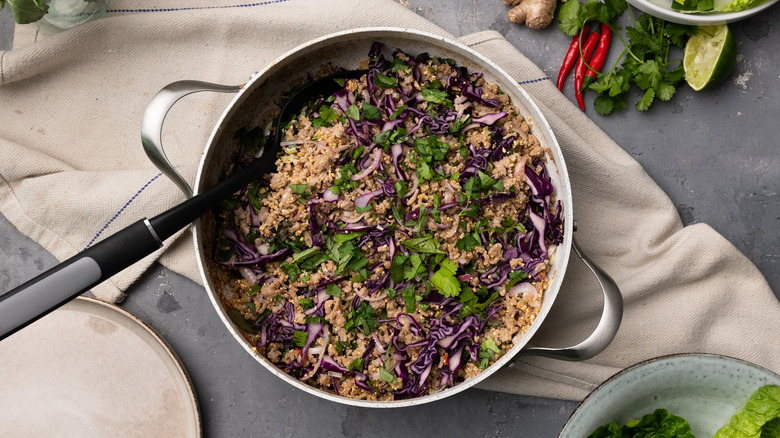
- 6 tablespoons uncooked Thai glutinous rice
- 1 tablespoon cooking oil
- 1 lb pork mince
- 2 tablespoons fish sauce
- 3 shallots, peeled and chopped
- 1 tablespoon finely grated ginger
- 1 lemongrass stalk, finely chopped
- 1 - 2 bird's eye chilies, finely chopped
- Juice 1 large lime
- ⅓ packed cup fresh mint, roughly chopped
- ⅓ packed cup fresh cilantro, roughly chopped
- ⅓ packed cup fresh Thai basil, roughly chopped
- ½ cup red cabbage, finely chopped
- 1 little gem lettuce, washed, to serve
- Heat up a pan to a medium heat, and then add the Thai glutinous rice to the dry pan and toast it until it is an even golden color. This should take roughly 10 minutes. Then remove the toasted rice from the pan and add it to a food processor. Grind the rice until it becomes a textured powder.
- Heat up a large frying pan to a medium-high heat. Add the oil to the pan and then add the pork mince, the fish sauce, and 2 tablespoons of water. Proceed to fry the pork mince until it is just cooked through.
- Add the chopped shallots, the ginger, the lemongrass, and the chilies to the pan. Mix everything in and then turn the heat off.
- Stir in the roughly chopped mint, the cilantro, and the Thai basil, along with the toasted rice powder and the red cabbage.
- Serve the larb hot and fresh with little gem lettuce leaves.
